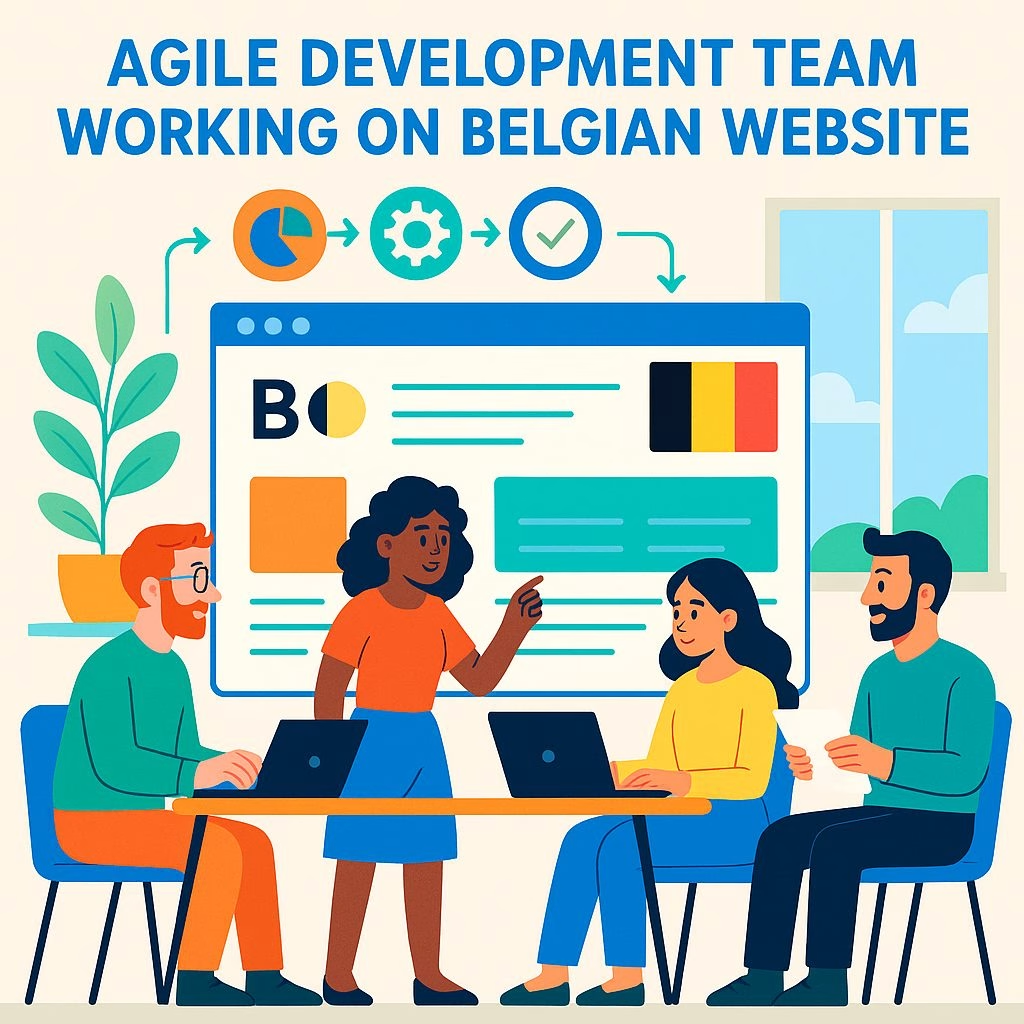Belgian businesses are facing an unprecedented digital transformation challenge. While traditional waterfall methodologies dominated the local web development scene for decades, the rapid pace of change in today’s multilingual market demands a more adaptive approach. I’ve witnessed countless Brussels-based startups struggle with lengthy development cycles, only to launch websites that no longer meet their trilingual audience’s evolving needs.
The solution lies in embracing agile development methodology—a framework that’s revolutionizing how Belgian companies approach website ontwikkeling. Projects managed with Agile methodologies report a success rate of 75%, contrasting sharply with traditional project management methods at 56%. More importantly for Belgian businesses, agile enables rapid iteration across Dutch, French, and German language versions while maintaining GDPR compliance throughout the development process.
Understanding Agile Methodology

Agile development represents a fundamental shift from rigid, sequential approaches to flexible, iterative processes. Rather than spending months planning every detail upfront, agile teams work in short sprints—typically 2-4 weeks—delivering functional website components that can be tested and refined continuously.
In my years consulting Belgian businesses, I’ve seen how this approach particularly benefits companies operating in our complex linguistic landscape. Traditional development often meant choosing one language first, then translating later. Agile allows simultaneous development across all three official languages, ensuring cultural nuances aren’t lost in translation.
Core Agile Principles
The methodology rests on four foundational values that resonate strongly with Belgian business culture:
- Individuals over processes: Emphasizing team collaboration rather than rigid bureaucratic structures
- Working software over documentation: Delivering functional websites rather than extensive specification documents
- Customer collaboration over contracts: Continuous client feedback instead of fixed-scope agreements
- Responding to change over plans: Adapting to market shifts rather than following predetermined paths
Belgian Market Context
Belgium’s unique trilingual environment creates specific challenges that agile methodology addresses exceptionally well. Approximately 60% of the Belgian population speaks Dutch, nearly 40% speaks French, and only 1% chooses German. This linguistic distribution means website ontwikkeling must consider three distinct user experiences simultaneously.
Regional Considerations
Flanders (Dutch-speaking region): Users expect clean, functional designs with straightforward navigation. E-commerce sites perform best with detailed product specifications and transparent pricing structures.
Wallonia (French-speaking region): Visual appeal carries greater weight, with users preferring elegant layouts and sophisticated imagery. Content-heavy sites need careful typography and spacing considerations.
Brussels (Bilingual region): The capital’s international character demands seamless language switching capabilities. Government and B2B sites must accommodate both French and Dutch equally.
German-speaking communities: Though small, this market segment values precision and comprehensive information architecture.
Agile Implementation Strategies
Sprint Planning Excellence
Successful agile implementation in Belgium requires careful sprint planning that accounts for multilingual testing cycles. I typically recommend 3-week sprints for Belgian projects—enough time for development, translation review, and cultural adaptation across all language versions.
Each sprint should include:
- Week 1: Core functionality development
- Week 2: Multilingual implementation and localization
- Week 3: Testing, GDPR compliance verification, and stakeholder feedback
GDPR Integration Framework
European data protection regulations aren’t afterthoughts in agile development—they’re integral to every sprint. Belgian DPA recently ordered controllers to bring websites’ cookie banners into GDPR compliance by adding reject buttons within the first layer, highlighting the importance of privacy-by-design approaches.
Key GDPR considerations for each sprint:
- Data minimization: Collecting only necessary user information
- Consent mechanisms: Implementing compliant cookie banners and form submissions
- Right to erasure: Building data deletion capabilities from day one
- Privacy impact assessments: Regular evaluation of new features’ privacy implications
Technical Implementation Approaches
Framework Selection
Belgian businesses benefit from agile-friendly development frameworks that support rapid multilingual deployment:
React.js with Next.js: Excellent for single-page applications requiring dynamic language switching. Perfect for Brussels-based SaaS companies serving international markets.
WordPress with WPML: Ideal for content-heavy sites where non-technical stakeholders need content management capabilities. Popular among Antwerp agencies managing multiple client sites.
Laravel with localization packages: Robust choice for complex web applications requiring sophisticated user authentication and data processing. Frequently chosen by Ghent-based fintech companies.
Database Architecture
Agile development in multilingual environments requires flexible database structures. I recommend implementing UTF-8 encoding from project inception, with separate tables for translatable content. This approach enables rapid content updates without affecting core functionality.
Quality Assurance Protocols
Automated Testing Suites
Belgian websites must function flawlessly across three languages while maintaining performance standards. Automated testing becomes crucial for agile teams managing this complexity.
Essential testing components:
- Unit tests: Verifying individual functions work correctly across language versions
- Integration tests: Ensuring different system components communicate properly
- End-to-end tests: Simulating complete user journeys in Dutch, French, and German
- Performance tests: Maintaining loading speeds despite multilingual content overhead
Manual Testing Procedures
Automated tests can’t catch cultural nuances or linguistic subtleties. I always recommend involving native speakers from different Belgian regions during sprint reviews. A Flemish user might interpret navigation differently than a Walloon user, even when using identical functional elements.
Stakeholder Communication Methods
Daily Standups Adaptation
Traditional agile standups work well for technical teams, but Belgian projects often involve stakeholders from different linguistic backgrounds. I’ve found success with structured status reports that include:
- Yesterday’s achievements: Specific to each language version
- Today’s goals: Prioritized by market segment impact
- Identified blockers: Particularly translation or cultural adaptation challenges
Sprint Reviews Excellence
Sprint reviews in multilingual environments require careful orchestration. I typically organize separate demo sessions for Dutch and French stakeholders, ensuring each group sees content in their preferred language. This approach increases engagement and provides more meaningful feedback.
Performance Optimization Techniques
Content Delivery Networks
Belgian users expect fast loading times regardless of their location or language preference. Implementing CDN solutions like Cloudflare or Amazon CloudFront ensures consistent performance across Flanders, Wallonia, and Brussels.
Optimization priorities:
- Image compression: Reducing file sizes without compromising visual quality
- Code minification: Streamlining CSS and JavaScript files
- Caching strategies: Balancing dynamic content needs with performance requirements
- Progressive loading: Prioritizing above-the-fold content across all language versions
Mobile Responsiveness Standards
Agile adoption among developers has soared from 37% to 86% in the last 5 years, largely driven by mobile-first development needs. Belgian users increasingly access websites via smartphones, making responsive design non-negotiable.
Mobile optimization considerations:
- Touch-friendly navigation: Ensuring buttons and links work well on smaller screens
- Readable typography: Maintaining legibility across different font sizes and languages
- Fast loading: Optimizing for varied mobile network speeds throughout Belgium
- Offline functionality: Providing graceful degradation when connectivity is poor
Budget Management Strategies
Cost Estimation Accuracy
Agile development often faces skepticism from Belgian businesses concerned about budget overruns. In my experience working with companies from Leuven to Liège, transparent cost tracking throughout each sprint builds confidence and prevents surprises.
Effective budget management includes:
- Story point estimation: Assigning complexity values to development tasks
- Velocity tracking: Measuring team productivity over multiple sprints
- Scope adjustment: Modifying features based on budget constraints
- Value prioritization: Focusing resources on highest-impact functionality
ROI Measurement Framework
Belgian businesses need clear metrics demonstrating agile methodology’s value. I recommend tracking:
- Time to market: Comparing agile vs. traditional development timelines
- Feature adoption rates: Measuring user engagement with newly released functionality
- Maintenance costs: Evaluating long-term code maintainability benefits
- Client satisfaction scores: Quantifying stakeholder happiness with development process
Common Implementation Challenges
Cultural Resistance Management
One of my most memorable projects involved a traditional Brussels manufacturing company transitioning to agile development for their B2B portal. The initial resistance was substantial—decades of waterfall thinking don’t disappear overnight. Agile adoption presents notable challenges, with widespread resistance to organizational change and cultural clashes emerging as significant obstacles, marking a 7-point increase from 2022.
Success required patience, education, and demonstrating quick wins. We started with a small pilot project—redesigning their Dutch product catalog. Within three sprints, they saw improved user engagement and realized agile’s potential.
Technical Debt Accumulation
Rapid development cycles can sometimes prioritize speed over code quality, leading to technical debt accumulation. Belgian projects face additional complexity because bugs often manifest differently across language versions.
Prevention strategies:
- Code review protocols: Mandatory peer reviews before merging changes
- Refactoring sprints: Dedicated time for improving existing code
- Documentation standards: Maintaining clear technical documentation
- Automated quality checks: Using tools like SonarQube to identify potential issues
Tools and Technologies
Project Management Platforms
Atlassian JIRA was among the most recommended tools for agile project management. For Belgian teams, I particularly recommend platforms offering multilingual interfaces and cultural localization options.
Top recommendations:
- Jira: Comprehensive issue tracking with customizable workflows
- Trello: Visual project boards ideal for smaller teams
- Azure DevOps: Microsoft’s integrated development environment
- Monday.com: User-friendly interface with excellent reporting capabilities
Development Environment Setup
Belgian development teams benefit from consistent, reproducible environments that support multilingual testing. Docker containers have become essential for ensuring code works identically across different developers’ machines and production servers.
Future-Proofing Strategies
Emerging Technology Integration
Belgium’s position as a European Union hub makes it crucial for local businesses to stay ahead of technological trends. The AI Act was approved by the European Council in May 2024, and will be fully applicable within 24 months, requiring Belgian websites to prepare for new AI regulation compliance.
Agile methodology’s flexibility enables rapid adaptation to emerging requirements:
- AI integration: Incorporating chatbots and automated customer service
- Voice interfaces: Preparing for multilingual voice search optimization
- Progressive web apps: Bridging gap between websites and mobile applications
- Blockchain integration: Preparing for decentralized authentication systems
Regulatory Compliance Evolution
European digital regulations continue evolving, requiring websites to adapt quickly. Agile teams can respond to new requirements through dedicated compliance sprints, ensuring Belgian businesses maintain legal compliance without disrupting core functionality.
Success Measurement Metrics
Key Performance Indicators
Belgian businesses need concrete metrics demonstrating agile methodology’s effectiveness. I recommend tracking both technical and business metrics:
Technical Metrics:
- Deployment frequency: How often new features reach production
- Lead time: Duration from concept to user-facing implementation
- Mean time to recovery: Speed of fixing critical issues
- Change failure rate: Percentage of deployments causing problems
Business Metrics:
- User engagement: Time spent on site across language versions
- Conversion rates: Sales or lead generation effectiveness
- Customer satisfaction: Net Promoter Scores and user feedback
- Market responsiveness: Speed of adapting to competitive changes
Long-term Evaluation Framework
Agile methodology’s true value emerges over extended periods. I recommend quarterly assessments examining:
- Team velocity trends: Whether development speed improves over time
- Code quality evolution: Reduction in bugs and maintenance overhead
- Stakeholder satisfaction: Improving client relationships and communication
- Market position: Competitive advantages gained through rapid iteration
Actionable Recommendations
Belgian businesses considering agile website ontwikkeling should start with these concrete steps:
Immediate Actions (Next 30 Days):
- Evaluate current development processes and identify bottlenecks
- Select pilot project suitable for agile methodology testing
- Train core team members in agile principles and practices
- Establish communication protocols for multilingual stakeholder management
Medium-term Goals (3-6 Months):
- Implement comprehensive testing automation for all language versions
- Develop GDPR compliance checklists integrated into sprint planning
- Create performance benchmarks specific to Belgian market expectations
- Build relationships with native speakers for cultural validation
Long-term Strategy (6-12 Months):
- Scale agile practices across entire development organization
- Develop expertise in emerging technologies while maintaining core competencies
- Establish metrics-driven improvement processes
- Create competitive advantages through superior market responsiveness
The transition to agile website development isn’t just about changing processes—it’s about embracing a mindset that prioritizes adaptation, collaboration, and continuous improvement. For Belgian businesses operating in our complex multilingual environment, agile methodology provides the flexibility needed to serve diverse audiences while maintaining technical excellence and regulatory compliance.
Success requires commitment from all stakeholders, from developers writing code to executives making strategic decisions. But the rewards—faster time to market, improved user satisfaction, and enhanced competitive positioning—make the journey worthwhile for forward-thinking Belgian organizations.







